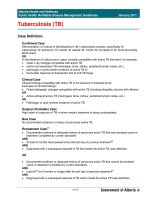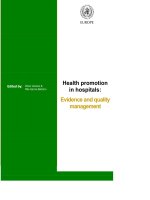29 health glucose management
Bạn đang xem bản rút gọn của tài liệu. Xem và tải ngay bản đầy đủ của tài liệu tại đây (660.88 KB, 18 trang )
UNIVERSITY
Health
Glucose Management
Lesson Overview
•
•
•
•
•
•
•
•
•
•
•
What is Insulin resistance and inflammation?
Why does it matter to us?
PED effect on Insulin resistance and inflammation
How do we test for insulin resistance?
What do we do about poor markers of blood glucose?
Sleep and Stress
Nutrition culprits and strategies
AAS, GH, Insulin
Metformin vs Berberine
Other Supplement Aids
Practical Summary
What is Insulin Sensitivity vs Resistance
In bodybuilding the term insulin sensitivity is a buzz word that is
overused and lacks clear definition and application.
Insulin resistance: Decreased tissue sensitivity or responsiveness to
insulin
What is the issue with Insulin Resistance?
Insulin resistance first develops in target tissues and there is a
compensatory increase in insulin to manage blood glucose. (normal
blood glucose, high serum insulin).
This can progress to decline in pancreatic beta cell function and
decreased insulin secretion and subsequential hyperglycemia and
glucotoxicity.
Decreased adipocyte insulin sensitivity leads to lipolysis and elevated
serum fatty acids, leading to increased hepatic glucose production.
This can cause major adverse health outcomes such as type 2
diabetes, cardiovascular disease, dyslipidemia, chronic kidney disease
and cancer.
One mechanism behind this is potentially low-grade chronic
inflammation.1
Inflammation and Insulin Resistance
•
•
•
•
•
Chronic Inflammation associated with body fat and weight gain (2)
High chronic inflammation lead to muscle mass loss (3)
After 20% body fat (30% females), with visceral fat accumulation, IL-6 and CRP
Levels increase
Visceral fat releases much larger cytokines than Sub Q body fat and related to
muscle mass loss (3). This may impede inflammatory muscle growth signaling
Rises in Autocrine and Paracrine cytokines local within muscle increases
hypertrophy (4)
Why does this matter for us?
• Steroid users current and former display lower insulin sensitivity via
increases in visceral adipose tissues and total body fat % (5)
• Multivariate adjustment identified VAT as independent predictor of
differences in insulin sensitivity, between current AAS abusers and
control participants, even though current AAS abusers displayed
lower body fat %
• Elevated CRP levels, with low grade inflammation
• Visceral fat increases increases inflammation and decreases insulin
sensitivity. Issues may occur at lower body fat % than natural
athletes.
• You may notice swelling, joint pain, lethargy, poor digestion,
decreased appetite
• Higher risk for morbidity and mortality
• Potential decrease in muscle hypertrophy response
How do we test for Insulin Resistance?
Lab test
Reference range
Interpretation and
Optimal
Fasting serum
Glucose
Normal: 70 – 99 mg/dl or 3.9 – 5.5 mmol/l Prediabetes: 100 – 125 mg/dl or 5.6 – 6.5 mmol/l
Diabetes: Greater than 126 mg/dl or 7 mmol/l
on more than one test sample
Most be fasted only water. Poor
sleep prior can elevate. No GH
prior to test. May give insight
into adrenal issues. Optimal 7585mg/dL
HgbA1c
Normal: Less than 5.7% Prediabetes: 5.7% to
6.4% Diabetes: greater than 6.5%
Average blood glucose over 3
months, screens for DM
Fasting Serum
Insulin
2 to 20 mIU/mL
Optimal <8mIU/mL
Measure of insulin production in
fasted state
Homeostatic
Model
Assessment of
Insulin
Resistance
(HOMA IR)
Less than 1.0 means you are insulin-sensitive
which is optimal.
Above 1.9 indicates early insulin resistance.
Above 2.9 indicates significant insulin
resistance.
How much insulin needed to
keep glucose in range
Serum
Triglyceride
Normal levels: Less than 150mg/dL Borderline
high:150 to 199
High: 200 to 499
Very high: 500 or more
High in hypothyroidism,
metabolic issues and DM.
Optimal <100mg/dL
High Sensitivity
C-Reactive
Protein
<1.0mg/L low risk; >3mg/L high risk of CVD
Test for inflammation in body
What do we do about it?
Insulin resistance and inflammation can be multifactorial.
A bodybuilder with high body weight, excess food intake, AAS usage,
GH usage, sleep/stress issues can all compile into poor health
outcomes.
Some of theses variables we accept and realize the health
implications, so we manage the variables we can control the best as
possible and be aware via lab testing.
Some of this is very genetic and your own interindividual response to
these stressors on the body, we can not change that aspect.
There is a lot more variables then the ones I will cover, but I will review
the most pertinent to us as bodybuilders that we can control.
Sleep
Decreased in sleep amount and quality has large impacts on insulin
resistance.
Mechanisms(6):
Increased release of counter-regulatory hormones, including
epinephrine and cortisol
Increased sympathetic nervous activity with elevated levels of
norepinephrine
Inflammation, with elevations of interleukin 1 beta (IL-1b), tumor
necrosis factor alpha (TNF-a), IL-6 and C-reactive protein (CRP)
Moderate sleep restriction during the week of 1 hour per night results
in less proportion of fat lost and a greater proportion of muscle loss in
a calorie deficit (7)
Degree of sleep apnea is inversely correlated to insulin sensitivity and
have higher HOMA IR than healthy people(6).
Stress
Mechanism:
Activation of the HPA axis via increased sympathetic response and
triggering increase in glucocorticoid production.
Cortisol inhibits insulin secretion from pancreatic beta cells and
decreased GLUT4 translocation, increased hepatic glucose
metabolism(8).
Excess Cortisol regulates adipose tissue differentiation, increased
visceral fat gain.
Cortisol inhibits amino acid uptake in skeletal muscle
In a group of 766 workers chronic work stress was associated with
insulin resistance (HOMA IR) and high cortisol levels. (9)
Workers with higher HOMA IR had higher demands at work and
insecurity at work than non-IR subjects.
Overfeeding and Body Fat Gain
Overconsuming calories
increases insulin resistance
and associated with increased
oxidative stress (10).
Whether that excess comes
from carbohydrate or fat, both
lead to same fat gain if calorie
equated.
Possible advantages in
consuming glucose over
fructose and linoleic acid over
saturated fat.
Overfeeding protein in
athletes has shown less fat
accrual and same FFM gains.
Control size of your surplus:
Ribeiro 2019 (11). Bbers overfed 4
weeks, 67.5 kcal/kg/d vs 50.1 kcal/kg/d
Limit the Cheat Meals
“A Single Day of Excessive Dietary Fat Intake Reduces Whole-Body
Insulin Sensitivity: The Metabolic Consequence of Binge Eating”
Parry et al 2017 (12)
Healthy participants fed 78% calorie surplus
After 1-day:
• Glucose AUC increased by 16.4%
• Whole body insulin sensitivity decreased 28%
Conclusion: Single day of overfeeding can rapidly impair glucose
metabolism and insulin sensitivity
Nutrition Strategies
Metabolic Flexibility: Ability to switch between fuel sources
Fasting vs Caloric Restriction (13)
Cardio (HIIT vs Steady State) and Weight training (14)
Energy Flex: high intake and high output vs low intake and low output
(15)
Dietary Composition
Fruit and Veggies decrease oxidative stress
Soluble and fermentable Fiber
Lower Xenobiotics (heavy metals, pesticides PCHC, dioxins, artificial
sweeteners) Protect Gut microbiota
Low in processed food
High in MUFA and PUFA
Omega 3 Fatty Acids
Magnesium
PEDS
AAS
Decrease total AAS load, cruise or physiological range
Reduce 17aa orals
GH
Hypothyroidism and insulin resistance
Decreased T4 to T3 conversion and Decrease TSH in growth hormone
deficiency patients
In normal healthy individuals only transient change seen, this is also
with dosages of 0.03mg/kg of BW (9IU for 220lb man) (16)
High dose (>0.01mg/kg/day) increased glucose and insulin levels
Low dose (<0.01mg/kg/day) only show transient changes in glucose
and then normalization (17)
Exogenous insulin
Early use of Slow and Fast acting insulin Decreased secretory demands
of pancreatic beta cells and preserve function (18).
Supplement/Drug Interventions
Product
Glucose
Actions
Antiinflammatory
actions
Side
Effects
Extra Notes
Effect on
Skeletal
Muscle
Effective
Dosing
Metformin
Decreased
Hepatic
Glucose
Production
Increased
Peripheral
insulin
sensitivity
Improved beta
cell function
Decreased GI
glucose
absorption
Decreased
inflammatory
factors and
oxidative
stress
Diarrhea,
flatulence,
bloating,
decreased
serum b12
Accumulative
effects take
4-5 days.
Extended
released may
provide less
GI distress
AMPk
activates
alpha 2
subunit in
skeletal
muscle not
alpha 1.
Hypertrophy
likely not
effected.
Decreased
V02 max.
Decreased
systemic IGF1
500-2000mg
BID or TID
Berberine
Decreased
Hepatic
Glucose
Production
Increased
Peripheral
insulin
sensitivity
Improved beta
cell function
Decreased GI
glucose
absorption
Decreased
inflammatory
factors and
oxidative
stress
Diarrhea
or
Constipati
on
Longer
duration of
use needed,
for high
serum levels.
Poor
bioavailabilit
y. Combined
w/metformin
at lower
dosages as
effective less
side effects.
Minimal data
available
900-2000mg
divided in
multiple
doses
Supplement/Drug Interventions
Product
Glucose
Actions
Antiinflammatory
actions
Side
Effects
Extra Notes
Effect on
Skeletal
Muscle
Effective
Dosing
Curcumin
AMPk effects,
more notable
for oxidation
and
inflammation
Increase SOD,
glutathione, and
catalase.
Decreased
adipokines.
>4g per
day GI
distress
n/a
Turmeric is
the spice,
Curcumin is a
chemical
present.
Curcumin
BCM-95
500mg twice
per day
ALA
AMPk
Upregulation
Reduces
biomarkers of
oxidation,
decreased
lipidperoxidatio
n. Increased
Glutathione
Toxic at
levels
>3g per
day
increase
d
oxidatio
n
n/a
Stimulate
glucose
uptake in
muscle via
AMPk
300-600mg
per day
Ceylan
Cinnamon
Inhibit
digestive
enzymes,
methylhydroxy
chalcone
polymer acts
as insulin
mimetic
Contains other
bioactive
flavonoids
Toxic in
high
dosages
Ceylon is
lower in
coumarin
(toxin)
compared to
cassia.
No evidence
1-6g per day
with meals
Overview of Practical Application
Year Round Any Phase
Monitor fasting BG 1-3x per week
Quality sleep practices, address sleep apnea
Stress management
Variety of Fruity and Veggies, Mixed fiber intake, omega 3s
Limit large cheat meals
Curcumin/ALA/Cinnamon
Keep NEAT high, walking after meals
Mass/Blast phase
Limit Body fat gain 15% male, 24% female
Minimum 3-5 days moderate intensity cardio
Limit oral AAS
Early initiation of Slow Active insulin (Lantus)
Further BG coverage at meals with Fast insulin (Humalog, etc)
Metformin and/or Berberine in combination (Limit Metformin to 500mg)
Sensitization Phase
Food reduction to maintenance level
Shift carbohydrate to protein/fats
Reduce total AAS load and GH <0.01mg/kg/day
No Cheat meals, macro dieting
Metformin and Berberine as needed, taper off
Taper insulin usage based on blood glucose
Increase energy flux if food intake is too low (NEAT increase + food increase)
References
1.
Tateya S, Kim F, Tamori Y. Recent advances in obesity-induced inflammation and insulin resistance. Front Endocrinol (Lausanne). 2013 Aug 8;4:93.
doi: 10.3389/fendo.2013.00093. PMID: 23964268; PMCID: PMC3737462.
2.
Saito I, Yonemasu K, Inami F. Association of body mass index, body fat, and weight gain with inflammation markers among rural residents in
Japan. Circ J. 2003;67(4):323-329. doi:10.1253/circj.67.323
3.
Orsatti FL, Nahas EA, Orsatti CL, et al. Muscle mass gain after resistance training is inversely correlated with trunk adiposity gain in postmenopausal
women. J Strength Cond Res. 2012;26(8):2130‐2139. doi:10.1519/JSC.0b013e318239f837
4.
Mitchell CJ, Churchward-Venne TA, Bellamy L, Parise G, Baker SK, Phillips SM. Muscular and systemic correlates of resistance training-induced
muscle hypertrophy. PLoS One. 2013;8(10):e78636. Published 2013 Oct 9. doi:10.1371/journal.pone.0078636
5.
Rasmussen JJ, Schou M, Selmer C, Johansen ML, Gustafsson F, Frystyk J, Dela F, Faber J, Kistorp C. Insulin sensitivity in relation to fat distribution and
plasma adipocytokines among abusers of anabolic androgenic steroids. Clin Endocrinol (Oxf). 2017 Sep;87(3):249-256. doi: 10.1111/cen.13372. Epub
2017 Jun 8. PMID: 28500659.
6.
Van Cauter E. Sleep disturbances and insulin resistance. Diabet Med. 2011 Dec;28(12):1455-62. doi: 10.1111/j.1464-5491.2011.03459.x. PMID:
21950773.
7.
Wang X, Sparks JR, Bowyer KP, Youngstedt SD. Influence of sleep restriction on weight loss outcomes associated with caloric restriction. Sleep.
2018;41(5):10.1093/sleep/zsy027. doi:10.1093/sleep/zsy027
8.
Rosmond R. Role of stress in the pathogenesis of the metabolic syndrome. Psychoneuroendocrinology. 2005 Jan;30(1):1-10. doi:
10.1016/j.psyneuen.2004.05.007. PMID: 15358437.
9.
Yan YX, Xiao HB, Wang SS, et al. Investigation of the Relationship Between Chronic Stress and Insulin Resistance in a ChinesePopulation. J Epidemiol.
2016;26(7):355-360. doi:10.2188/jea.JE20150183
10.
Samocha-Bonet D, Campbell LV, Mori TA, et al. Overfeeding reduces insulin sensitivity and increases oxidative stress, without altering markers of
mitochondrial content and function in humans. PLoS One. 2012;7(5):e36320. doi:10.1371/journal.pone.0036320
11.
Ribeiro AS, Nunes JP, Schoenfeld BJ, Aguiar AF, Cyrino ES. Effects of Different Dietary Energy Intake Following Resistance Training on Muscle Mass
and Body Fat in Bodybuilders: A Pilot Study. J Hum Kinet. 2019 Nov 30;70:125-134. doi: 10.2478/hukin-2019-0038. PMID: 31915482; PMCID:
PMC6942464.
12.
Parry SA, Woods RM, Hodson L, Hulston CJ. A Single Day of Excessive Dietary Fat Intake Reduces Whole-Body Insulin Sensitivity: The Metabolic
Consequence of Binge Eating. Nutrients. 2017;9(8):818. Published 2017 Jul 29. doi:10.3390/nu9080818
13.
Aksungar FB, Sarıkaya M, Coskun A, Serteser M, Unsal I. Comparison of Intermittent Fasting Versus Caloric Restriction in Obese Subjects: A Two Year
Follow-Up. J Nutr Health Aging. 2017;21(6):681-685. doi: 10.1007/s12603-016-0786-y. PMID: 28537332.
14.
Borghouts LB, Keizer HA. Exercise and insulin sensitivity: a review. Int J Sports Med. 2000 Jan;21(1):1-12. doi: 10.1055/s-2000-8847. PMID: 10683091.
15.
Paris HL, Foright RM, Werth KA, Larson LC, Beals JW, Cox-York K, Bell C, Melby CL. Increasing energy flux to decrease the biological drive toward
weight regain after weight loss - A proof-of-concept pilot study. Clin Nutr ESPEN. 2016 Feb;11:e12-e20. doi: 10.1016/j.clnesp.2015.11.005. Epub 2015
Dec 29. PMID: 28531421.
16.
Sgrò P, Sansone M, Parisi A, Sartorio A, Sansone A, Romanelli F, Lenzi A, Di Luigi L. Supra-physiological rhGH administration induces gender-related
differences in the hypothalamus-pituitary-thyroid (HPT) axis in healthy individuals. J Endocrinol Invest. 2016 Dec;39(12):1383-1390. doi:
10.1007/s40618-016-0489-6. Epub 2016 May 26. PMID: 27230547.
17.
Kim SH, Park MJ. Effects of growth hormone on glucose metabolism and insulin resistance in human. AnnPediatr Endocrinol Metab. 2017
Sep;22(3):145-152. doi: 10.6065/apem.2017.22.3.145. Epub 2017 Sep 28. PMID: 29025199; PMCID: PMC5642081.
18.
Nyalakonda K, Sharma T, Ismail-Beigi F. Preservation of beta-cell function in type 2 diabetes. Endocr Pract. 2010 Nov-Dec;16(6):1038-55. doi:
10.4158/EP10112.RA. PMID: 21030360.









